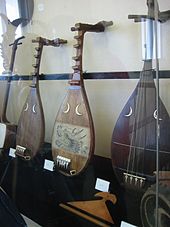Biwa
Biwa ( jap. 琵琶 ) is a classical Japanese musical instrument , a four- or five-string, pear-shaped short-necked lute that is struck with a large plectrum ( 撥 , bachi ). It is derived from the Chinese pipa , which came to Japan in the Nara period (710–794). Both sounds are written with the same characters. In earlier times the biwa was used by blind singing monks, the so-called biwa hōshi , to perform ballads. Today, however, it is no longer in widespread use.
The biwa gave the largest Japanese inland lake, Lake Biwa , its name, perhaps because it has a similar shape. On Lake Biwa itself there is an island with a shrine to the goddess Benten . As the best-known of its attributes, it again has the lute biwa .
In other characters ( 枇杷 ), but the same phonetic components posted the Japanese word called biwa (also from Chinese pipa ), the Japanese loquat -Frucht ( Eriobotrya japonica ).
literature
- Hugh De Ferranti: Composition and improvisation in Satsuma biwa. In: Laurence Picken (Ed.): Musica Asiatica. Cambridge University Press, Cambridge 1991, pp. 102-127
- Silvain Guignard: Biwa Traditions. In: Robert C. Provine, Yosihiko Tokumaru, J. Lawrence Witzleben (Eds.): Garland Encyclopedia of World Music. Volume 7: East Asia: China, Japan, and Korea. Routledge, London 2002, pp. 643-651
- Heinz-Eberhard Schmitz: Satsumabiwa. The sounds of the samurai. (Robert Günther (Ed.): Studies on Traditional Music of Japan, 7 ) 2 volumes. Bärenreiter, Kassel 1994
